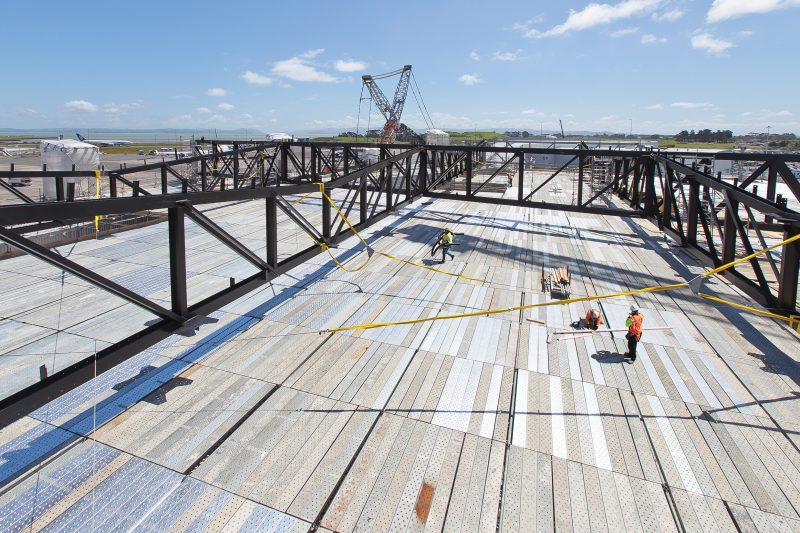D&H Steel – manufacturing in the construction game
-by Lisa van Beurden
D&H Steel Construction is an Auckland-based structural steel contractor with its fingerprints over many of the largest structural steel projects nationwide.
For almost 50 years it has led innovation in the steel industry, from being an early adopter of welded beams and on-the-ground erection techniques to, more recently, driving quality management systems in fabrication.
The company straddles manufacturing and construction. “While we are a structural steel fabricator for the building industry, we consider ourselves a manufacturing operation as 70 percent of our work is undertaken in our workshop facilities,” says D&H Steel managing director Wayne Carson.
Looking ahead at the next 12 months, D&H Steel has a very strong order book, of which some is a function of pent-up demand spilling over from COVID-related lockdowns and slowdowns, says Carson.

Beyond that Carson says that there is less certainty but COVID and other market influences have led industry players to focus more on financial sustainability.
“The industry is giving greater consideration to risk and making firmer decisions,” says Carson. “We have a more robust market as a result.”
COVID has had other impacts. For the last few months, D&H Steel has been very disrupted by the effects of COVID, more than expected, especially around the shipping and supply of product, says Carson.
As a result, the company has had to take a more conservative approach to procurement processes.
“Just-in-time procurement has been shown to be very high risk across all industries so we’re having to carry higher stock levels, and having to allow for longer lead times to procure job-specific materials.
“It means we need to get started on projects earlier than previously, which, in turn, means an earlier commitment from clients to get the procurement process underway.”
D&H Steel has retail customers that are accelerating new building programmes because they cannot rely on just-in-time deliveries. Carson says it will lead to more demand for warehousing and transport hubs as retailers look to strengthen their storage and delivery capability.
Carson says that when COVID hit the company moved into survival mode with the full support of its staff. “The onset of COVID has proven that our business is agile but we need to be even more so. We are growing our people to accept that change is healthy and, as a result of what we’ve been through, we are a better business and must continue to adapt.”
COVID has amplified the industry’s skills famine and D&H Steel has had to change its recruitment model, which combined some local training with sourcing skilled staff from offshore.
The company is now even more firmly focused on its apprenticeship training programme and upskilling local people.
“It is extremely hard to find the right people so we have to train them,” says Carson. “It’s a five-six year process but we started about four years ago when our industry, and other industries, realised that we can’t simply rely on importing staff.
“We’ve seen the value of increasing our commitment to training apprentices and investing in our staff. So we’re partway down that track but we still have some way to go.”
The steel industry is an integral part of local communities nationwide, says Carson, and having a diverse team is extremely important to D&H Steel’s business.
“It strengthens our resilience and our respect for others we deal with, such as clients, consultants and other trades,” says Carson. “It has also presented opportunities for us to access new areas of the workforce, including Māori and Pasifika communities.”
Diversity and inclusion is part of a wider sustainability initiative that the company, and the wider structural steel industry, is pursuing.
Today, the definition of sustainability is wide ranging, and D&H Steel has found it helpful to identify the different areas of focus: financial health, growing and supporting the workforce, environmental sustainability and being a responsible member of the community.
“By putting an overarching name to these we have been able to identify our strengths and weaknesses. We have set improvement goals, assigned KPIs and started to measure our progress,” says Carson.
“While we’re already proud of our contribution to the community, as a result of applying a sustainability lens to these, we are becoming a much stronger, more responsible corporate and community member.”
In terms of future opportunities, D&H Steel is focused on strengthening its client relationships and proactively growing structural steel as a preferred building material.
“Structural steel itself is a cost-competitive option, offering a wide range of sustainable solutions,” says Carson. “From both a structural performance and a robust supply chain perspective, structural steel is now a well-accepted, well-refined and low-risk building alternative.”
As a result, the past two decades have seen demand for structural steel solutions grow substantially. Today, structural steel’s share of the multi-level construction market is more than 50 percent nationwide.
In Christchurch, due to structural steel’s strong seismic performance, its market share is over 80 percent – up from virtually nil before the Canterbury earthquakes. Steel is also becoming the preferred material in Wellington because of the local seismic issues.
So, what’s next for D&H Steel?
“We are embarking on an Industry 4.0 development programme,” says Carson.
Otherwise known as the Fourth Industrial Revolution, Industry 4.0 relates to both the capture and better use of business and manufacturing data, and to the connectivity of data to bridge the physical and digital worlds.
Carson says the aim is to use data to enable autonomous decision-making processes.
“It’s an innovative approach to better managing a business’ processes. It uses leading-edge technology to monitor assets and processes and provide status updates in real-time, and it enables scenario planning without putting assets at risk,” says Carson.
It also allows real-time connected value creation networks by involving stakeholders early, and encouraging vertical and horizontal integration.
“You can take a more holistic view of your business and pick out things that are worth focusing on,” says Carson. “It’s the future of manufacturing.”



